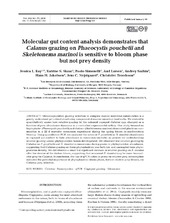| dc.contributor.author | Ray, Jessica Louise | |
| dc.contributor.author | Skaar, Katrine Sandnes | |
| dc.contributor.author | Simonelli, Paolo | |
| dc.contributor.author | Larsen, Aud | |
| dc.contributor.author | Troedsson, Christofer | |
| dc.date.accessioned | 2016-04-07T07:09:36Z | |
| dc.date.available | 2016-04-07T07:09:36Z | |
| dc.date.issued | 2016-01-19 | |
| dc.Published | Marine Ecology Progress Series 2016, 542:66-77 | eng |
| dc.identifier.issn | 0171-8630 | en_US |
| dc.identifier.uri | http://hdl.handle.net/1956/11870 | |
| dc.description.abstract | Mesozooplankton grazing selection in complex marine microbial communities is a poorly understood yet critical structuring component of marine microbial food webs. We wished to quantitatively assess how relative grazing by the calanoid copepod Calanus spp. changed as a function of prey abundance dynamics in a controlled experimental setting. Our study focused on haptophyte- (Phaeocystis pouchetii) and diatom- (Skeletonema marinoi) dominated plankton communities in a 22 d seawater mesocosm experiment during the spring bloom in southwestern Norway. Using quantitative PCR, we analyzed the ratios of P. pouchetii or S. marinoi abundances in copepod gut content to their abundance in mesocosm seawater as proxies for understanding relative grazing across phytoplankton bloom development. We observed low relative grazing by Calanus on P. pouchetii and S. marinoi in mesocosms during peaks in phytoplankton abundance, suggesting that Calanus grazing on these phytoplankton was both low and uncoupled from phytoplankton density. We did observe a small but signficant increase in relative grazing on S. marinoi after the demise of the diatom bloom, suggesting that senescent S. marinoi may be more bioavailable prey for Calanus. In conclusion, the use of qPCR ratios as proxy for relative prey consumption indicates the potential importance of phytoplankton bloom phase, but not relative prey density, for Calanus prey selection. | en_US |
| dc.language.iso | eng | eng |
| dc.publisher | Inter-Research | en_US |
| dc.rights | Attribution CC BY 3.0 | eng |
| dc.rights.uri | http://creativecommons.org/licenses/by/3.0/ | eng |
| dc.subject | Calanus | eng |
| dc.subject | Raunefjorden | eng |
| dc.subject | qPCR | eng |
| dc.subject | Copepod grazing | eng |
| dc.subject | Mesocosm | eng |
| dc.title | Molecular gut content analysis demonstrates that Calanus grazing on Phaeocystis pouchetii and Skeletonema marinoi is sensitive to bloom phase but not prey density | en_US |
| dc.type | Peer reviewed | |
| dc.type | Journal article | |
| dc.date.updated | 2016-01-27T15:18:46Z | |
| dc.description.version | publishedVersion | en_US |
| dc.rights.holder | Copyright Uni Research Ltd 2016 | en_US |
| dc.identifier.doi | https://doi.org/10.3354/meps11560 | |
| dc.identifier.cristin | 1324315 | |
| dc.subject.nsi | VDP::Matematikk og Naturvitenskap: 400 | en_US |

